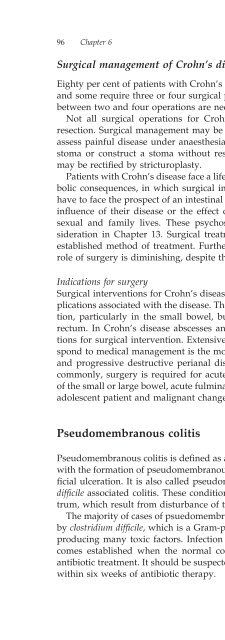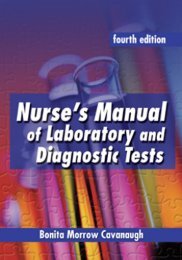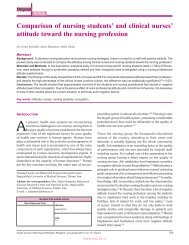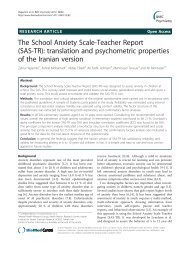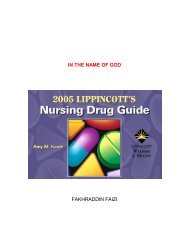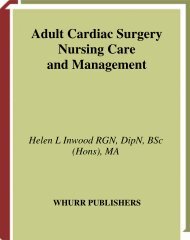Gastrointestinal Nursing.pdf
Gastrointestinal Nursing.pdf
Gastrointestinal Nursing.pdf
Create successful ePaper yourself
Turn your PDF publications into a flip-book with our unique Google optimized e-Paper software.
96 Chapter 6Surgical management of Crohn’s diseaseEighty per cent of patients with Crohn’s disease require at least one operationand some require three or four surgical procedures. It has been reported thatbetween two and four operations are necessary in most patients.Not all surgical operations for Crohn’s disease involve major intestinalresection. Surgical management may be required simply to drain an abscess,assess painful disease under anaesthesia, excise a fistulous track, refashion astoma or construct a stoma without resecting the bowel. Obstructed bowelmay be rectified by stricturoplasty.Patients with Crohn’s disease face a lifetime disorder, which may have metabolicconsequences, in which surgical intervention is common. Patients mayhave to face the prospect of an intestinal stoma and may be worried about theinfluence of their disease or the effect of surgical treatment on their social,sexual and family lives. These psychosocial issues are given further considerationin Chapter 13. Surgical treatment, however, is an important andestablished method of treatment. Furthermore, there is no evidence that therole of surgery is diminishing, despite the advances of drug therapy.Indications for surgerySurgical interventions for Crohn’s disease are usually performed for the complicationsassociated with the disease. The most common indication is obstruction,particularly in the small bowel, but also in the duodenum, colon andrectum. In Crohn’s disease abscesses and fistulae are also important indicationsfor surgical intervention. Extensive Crohn’s colitis that has failed to respondto medical management is the most common indication for colectomy,and progressive destructive perianal disease may require proctectomy. Lesscommonly, surgery is required for acute intestinal haemorrhage, perforationof the small or large bowel, acute fulminating colitis, growth retardation in theadolescent patient and malignant change.Pseudomembranous colitisPseudomembranous colitis is defined as an acute inflammation of the mucosa,with the formation of pseudomembranous plaques overlying an area of superficialulceration. It is also called pseudomembranous enteritis and clostridiumdifficile associated colitis. These conditions are part of the same disease spectrum,which result from disturbance of the normal intestinal lining.The majority of cases of psuedomembranous colitis involve toxins producedby clostridium difficile, which is a Gram-positive, anaerobic bacteria capable ofproducing many toxic factors. Infection is usually hospital-acquired and becomesestablished when the normal colonic bacterial flora is disrupted byantibiotic treatment. It should be suspected in patients who develop diarrhoeawithin six weeks of antibiotic therapy.


